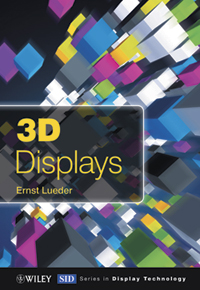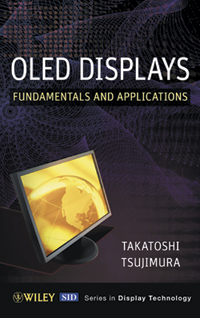3D Displays
by Ernst Lueder
Reviewed by Brian Schowengerdt
SID–Wiley Series

3D is one of the hottest topics in the display industry today. With the commercial success of stereoscopic films, television manufacturers have moved quickly to introduce stereoscopic TVs, attempting to channel that success into the home-entertainment market. For the past few years at the SID International Symposia, the 3D technology track has been by far the largest at the conference, showcasing a staggeringly diverse array of work in the field.
Ernst Lueder's latest book in the SID–Wiley series, 3D Displays, does an excellent job of taking the incredible diversity of 3D display development and distilling it into key sub-areas. The book presents a broad survey of work in 3D displays, from the glasses-based stereoscopic displays that currently dominate the home market to cutting-edge holographic and volumetric developments that are paving the way to displays on the horizon. As such, it provides an excellent reference for a reader interested in a broad education in 3D technologies.
The author also wrote Liquid Crystal Displays: Addressing Schemes and Electro-Optical Effects, which has sold more books than any other in the SID-Wiley series. As befits his extensive expertise in LC flat-panel displays and underlying drive electronics, 3D Displaysprovides particularly rich and deep discussions of 3D displays built upon flat-panel-display technologies. The chapters on stereoscopic, autostereoscopic, and integral-imaging displays especially have benefited from this knowledge base.
Presenting a detailed taxonomy of the glasses-based stereoscopic display, the author discusses area-multiplexed and time-multiplexed approaches in some depth. In addition to physical and optical characterizations, he presents the circuits, driving schemes, and algorithms powering these displays. A similar treatment is given to glasses-free autostereoscopic displays, discussing spatially multiplexed approaches using barriers and lenticulars, time-sequential approaches with directional backlights, switchable 2D/3D displays, and the markedly different approach of depth-fused displays. The chapter on autostereoscopic displays also includes a brief discussion of a head-worn near-to-eye 3D display – though this would have been more at home in a chapter dedicated to helmet-mounted, head-worn, and other near-to-eye displays, which is the one major category of 3D displays not treated explicitly in the book.
On some topics outside of flat-panel-based 3D displays, such as some of the technologies presented in the chapter on volumetric displays, or regarding details of interaction between 3D displays and the human-visual system, the footing is a bit less stable. Though the chapter on the human-visual system and 3D perception provides a concise and useful summary of basic processes, the section addressing accommodation–vergence mismatch would have benefited from the inclusion of some of the latest work from, e.g., Martin Banks's lab at UC Berkeley, which has made significant inroads toward quantifying the effect of this mismatch in displays on the human-visual system. On a related topic, the book suggests that integral-imaging displays, such as volumetric displays, produce congruent cues to accommodation and vergence. While this can be argued for some particular configurations of integral-imaging displays, it does not apply to the class as a whole. However, these minor quibbles are easy to overlook in an otherwise excellent text that has taken on the Herculean task of summarizing such a broad body of work.
In addition to discussing core 3D display technologies, the author has provided an extensive discussion of techniques and metrics to assess the quality of 3D displays. This discussion segues from a thorough discussion of various algorithms used to extract depth information from stereoscopic images for quality analysis, to a strong treatment of 2D-to-3D conversion algorithms to tap the large body of existing 2D media for 3D content.
In summary, 3D Displays is encyclopedic in scope, a great reference, and a recommended purchase.
Brian Schowengerdt is the Guest Editor for 3D technology for ID magazine, SID's Program Vice Chair for 3D, and an Associate Editor of the Journal of the SID. He is a senior research scientist at the University of Washington's Human Photonics Lab.
OLED Displays: Fundamentals and Applications
by Takatoshi Tsujimura
Reviewed by Denis Y. Kondakov
SID–Wiley Series

Arguably, no other display technology can compete with OLEDs with respect to how fast the field is growing. There is a lot of excitement about OLEDs in both the industry and the academic world. This fast growth and excitement go hand in hand with the rapid pace of research and development in nearly orthogonal subfields ranging from OLED display design and manufacturing to OLED material design, and from OLED device architecture to design and implementation of OLED display components. There is no question that OLEDs are a remarkably challenging field to follow in their entirety, especially if one relies on publications such as papers and conference proceedings. It is particularly challenging (or, perhaps, even more so) for someone who is just starting in this field or trying to expand their area of expertise to adjacent subfields.
Generally speaking, books are indispensable in science and technology when learning about a new field and OLEDs are no exception. However, practically none of the OLED-related books published so far provides more than mostly arbitrarily selected and fragmentary topics of interest arranged in a manner similar to what is usually found in scientific review papers. In sharp contrast, OLED Displays: Fundamentals and Applications aims to cover the entire field of OLEDs in a coherent manner. Being written by a sole author – T. Tsujimura – it is clearly effective in the creation of a consistent and internally logical framework. Chapter by chapter, Tsujimura systematically covers most if not all aspects of OLEDs. Many important subjects are covered in great detail, with enough technical depth to be valuable to more sophisticated readers. In the spirit of the adage "a single picture is worth a thousand words," the book has many useful graphics that effectively communicate the subject matter.
Some subjects receive a briefer treatment, which is not surprising considering the sheer size of the field being covered. There are some rather abbreviated topics, such as the section on OLED materials. A few fundamental concepts and mainstream designs – doped charge-transport layers, charge-generation layers, and hole-injection interfaces – are missing. And there are some unfortunate choices of representative examples, such as picking a non-fluorescent coumarin (its derivatives are indeed highly fluorescent) to demonstrate light-emitting material.
Overall however, despite a few shortcomings, this work will be a valuable and currently unique resource for anyone interested in learning about OLEDs in general and of particular interest to engineers, managers, and other industry professionals entering the field or expanding their areas of expertise.
In 1991, Denis Y. Kondakov received his doctorate from St. Petersburg University, Russia, working in the area of free-radical chemistry of organometallics. After post-doctoral research in the field of early transition metal complexes mediated synthesis with T. Takahashi at IMS, Okazaki, Japan, and E. Negishi at Purdue University, U.S., he joined Eastman Kodak Company to work on reaction mechanisms and photochemistry of azomethine photographic dyes. Since 2001, his work has focused on device physics, photochemistry, and material design of small-molecule-based OLED devices. In 2011, he joined DuPont to work on printed OLED technologies. •